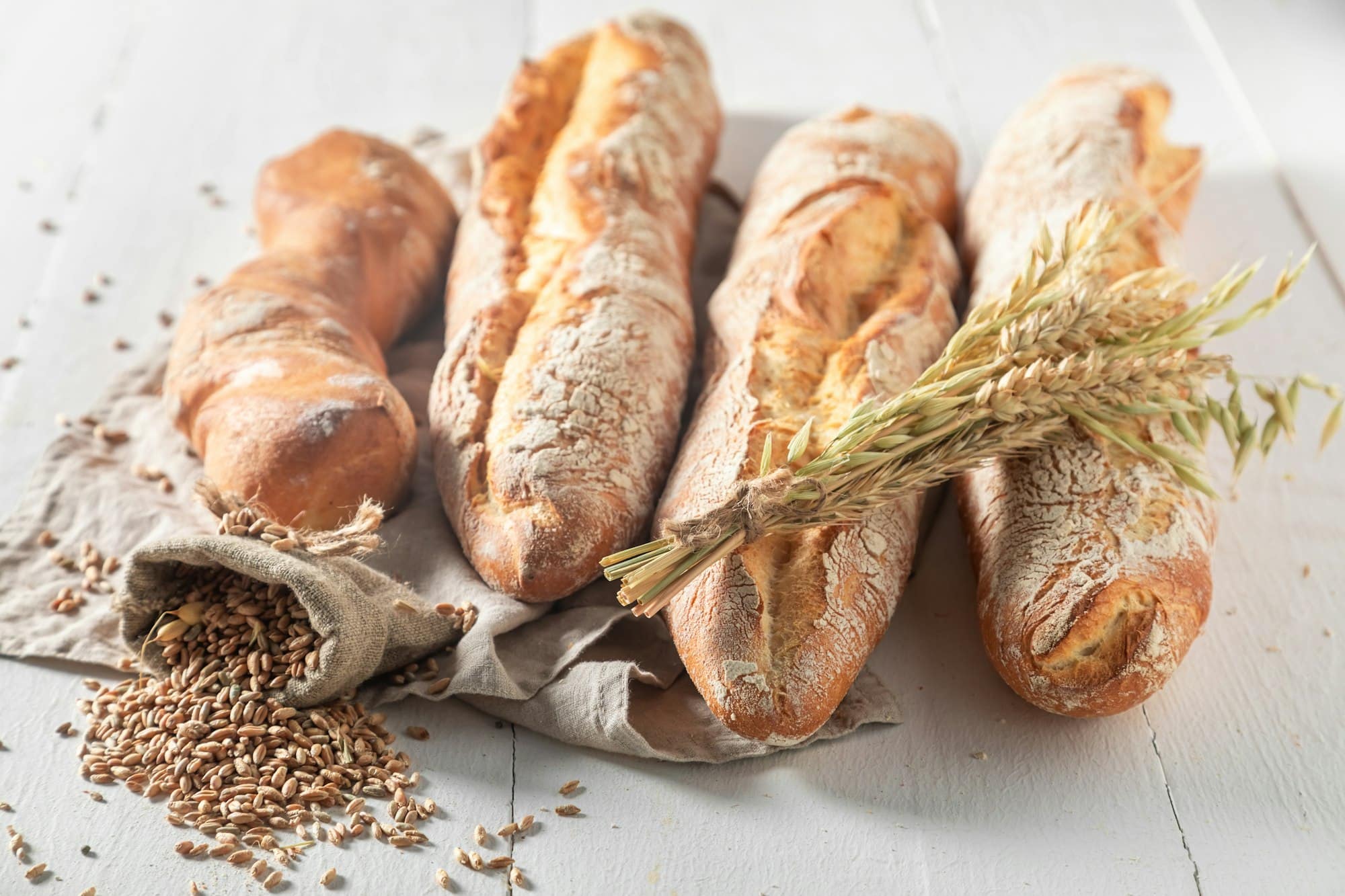What’s the Key to Perfectly Crusty French Baguettes with a Chewy Interior?

There’s no denying the allure of a perfectly made French baguette. The crackly brown crust giving way to a pillowy-soft, chewy interior is enough to make the mouth water. Though many have tried replicating this bread at home, nothing can replace the genuine article. Yet, with the right recipe, a bit of patience, and some baking know-how, you can come extremely close. Let’s dive into the world of bread baking and unravel the mystique of the perfect French baguette.
The Importance of the Right Ingredients
An authentic French baguette is surprisingly simple in terms of ingredients. The list only includes flour, water, yeast, and salt. However, the quality of these ingredients can significantly affect the end result.
Avez-vous vu cela : Can You Create a Gourmet Quinoa Salad with Roasted Vegetables and Feta?
When it comes to flour, opt for a good quality bread flour. Bread flour has a higher protein content than all-purpose flour. This extra protein helps to create a strong gluten network, resulting in a chewy, elastic texture that characterizes an ideal baguette.
Yeast is another key player. Active dry yeast or fresh yeast are both suitable, but they need to be proofed before use. Proofing the yeast allows it to activate, ensuring that it will effectively leaven the dough.
A lire en complément : How to Prepare a Classic French Cassoulet with Duck and Sausage?
Water, too, plays a crucial role in baguette making. The water should be lukewarm, the right temperature to activate the yeast and create a dough that’s easy to handle.
Lastly, don’t forget the salt. Despite being a small addition, salt plays a dual role in bread-making. It adds flavor and controls the fermentation rate of the dough.
The Art of Dough Preparation
Once you’ve gathered your ingredients, it’s time to make the dough. Start by dissolving the yeast in warm water. Give it a few minutes to bloom. Meanwhile, in a large bowl, combine the flour and salt.
Next, make a well in the center of your flour mixture and pour in the yeast mixture. Stir to combine until the dough comes together. This is the initial mixing phase. The dough might be a bit ragged at this point, but don’t worry.
The next phase is kneading. Knead the dough on a floured surface for about 10 minutes until it becomes smooth and elastic. This kneading process is essential for developing the gluten structure in your dough.
After kneading, place the dough in a greased bowl, cover it with a clean cloth, and let it rise. This process, known as proofing, allows the yeast to ferment the dough, causing it to expand. The proofing time can vary, but typically, the dough should double in size, which usually takes about one to two hours.
Shaping and Baking the Baguettes
Now comes the moment of truth – shaping and baking the baguettes. Turn the dough out onto a lightly floured surface and divide it into equal-sized pieces. These pieces will be shaped into individual loaves.
Roll each piece into a rectangle, then roll it up like a jelly roll, pinching the seam to seal. This rolling action creates the signature length and shape of a baguette. Place the rolled loaves onto a baking pan, cover, and let them rise again until they are puffy and noticeably bigger, about 30 minutes to an hour.
Preheat your oven to a high temperature — typically around 450 degrees Fahrenheit. High heat is vital for achieving the crispy crust that distinguishes a great baguette. Before placing the loaves in the oven, make several diagonal slashes across the top of each loaf with a sharp knife. This allows the dough to expand and rise even more during baking.
The baking time will depend on your oven and the size of your loaves, but generally, it takes about 25-30 minutes to bake the baguettes to a beautiful golden brown.
Cooling and Storing your Baguettes
Just as important as the baking process is the cooling process. Once your baguettes are done baking, remove them from the oven and let them cool on a wire rack. This allows the steam inside the loaves to escape, preventing the crust from becoming soggy.
Baguettes are best enjoyed fresh, ideally the same day they are baked. However, if you need to store them, wrap them in a cotton cloth and keep them at room temperature. Avoid plastic bags, which can make the crust soft.
A Final Word on Making French Baguettes
Baking the perfect French baguette is both an art and a science. Understanding the steps and techniques involved is crucial, but so is practice and patience. Don’t be discouraged if your first few attempts don’t yield the perfect loaf. Keep trying, and remember, even a less-than-perfect homemade baguette is still a delicious accomplishment.
Remember, the key to a perfectly crusty baguette with a chewy interior lies in the quality of your ingredients, the preparation of your dough, the baking process, and proper cooling and storage. Happy baking!
The Role of Equipment in Making French Baguettes
It’s not just the ingredients and dough preparation that play a significant role in creating the perfect French baguette. The equipment you use can also greatly influence the outcome. If you’re serious about baguette-making, consider investing in a few key pieces of baking equipment.
A baguette pan is a special long, narrow pan designed specifically for baking baguettes. The pan helps the dough maintain its signature shape during the baking process. If you don’t have a baguette pan, you can also use a regular baking sheet, but be prepared for a slightly flatter loaf.
A baking stone is another piece of equipment that can enhance your bread-making experience. Baking stones are known for their ability to retain heat, which can help achieve that crispy, golden brown crust that’s characteristic of French baguettes.
When proofing your dough, consider using a proofing basket or "banneton." While not necessary, these baskets help the dough maintain its shape while rising.
Lastly, don’t underestimate the importance of a good, sharp knife. You’ll need this for scoring the tops of your loaves before baking, which allows the bread to expand and rise to its full potential.
Mistakes to Avoid When Making French Baguettes
Knowing what to do is one thing, but being aware of what not to do can be just as enlightening. Here are a few common mistakes to avoid when making French baguettes.
Firstly, don’t rush the process. Patience is key in bread making. Allow adequate time for the yeast to activate and for the dough to rise. Shortening these steps may result in a dense, flat loaf.
Another common mistake is using water that’s too hot. The perfect temperature for activating yeast is lukewarm, around 110 degrees Fahrenheit. Water that’s too hot can kill the yeast, while water that’s too cold might not activate it at all.
When it comes to baking, avoid opening the oven door too often. This can cause the temperature to drop, affecting the baking process. Remember, high heat is crucial for achieving a crispy crust.
Lastly, resist the temptation to slice into your freshly baked baguette right away. Let it cool on a wire rack to allow the steam to escape. Cutting into a hot loaf can result in a gummy interior.
Conclusion: The Delight in Making French Baguettes
In conclusion, achieving a perfectly crusty French baguette with a chewy interior requires careful attention to detail, quality ingredients, appropriate equipment, and above all, patience.
A good baguette recipe is easy to follow, but the true magic lies in the hands that knead the dough and the heart that nurtures the process. From the moment the yeast blooms in the warm water to the moment you remove the golden brown loaf from the oven, making a French baguette is a labor of love.
Remember to avoid common mistakes, like rushing the process or using water at the wrong temperature. Also, don’t forget that the equipment you use can significantly impact the end result.
At the end of the day, baking your French bread is a rewarding experience, regardless of the outcome. And when you finally achieve that perfect crusty exterior and chewy interior, it will have been worth every moment spent in the kitchen. Enjoy the process, learn from your mistakes, and keep baking. Bon appétit!
